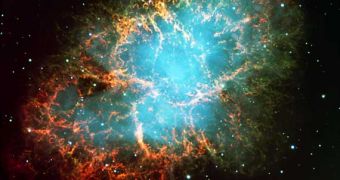Stars spend most of their lives burning hydrogen through nuclear fusion reactions to produce the energy required to remain stable as long as possible. By doing so, two hydrogen atoms are fused together to create a single helium atom and a fair amount of energy. However, at some point in time, the star will begin processing helium and other elements into heavier ones. During their lives, stars are able to produce all elements lighter than iron - including iron; all elements heavier than iron are produced during the supernova stage at the end of the star's life.
Although at first sight this appears to be simple, it isn't. We know that heavier-than-iron elements occur during the supernova explosion, nonetheless what is puzzling is the abundance of elements. Theory says that fewer should be produced, but observations contradict these predictions. According to scientists, the rapid neutron capture process is to blame. Heavy elements are grown inside stars by capturing neutrons, which later decay into protons to balance the nuclei of the newly created elements.
Alternatively, some scientists believe that a fission cycling process takes place simultaneously with the rapid neutron capture, to create heavier-than-iron elements. This means that unstable neutron-rich nuclei split into lighter nuclei that will serve as base for a new nucleus which will further grow through neutron capture. The problem is that the supernova stage does not match the conditions required to carry out any of the two processes.
What happens?
Gail McLaughlin from the North Carolina State University believes that heavy element production takes place after the supernova explosion, when neutron-rich nuclei blast outwards high amounts of neutrino. This scenario however takes place only in special supernova explosions that form neutron stars. During the supernova explosion, fission cycling and rapid neutron capture processes are able to create high amounts of heavy elements in the neutrino 'wind'.
McLaughlin discovered that, for atoms with atomic numbers greater than 130, the conditions for heavy nuclei formation are much looser, thus explaining the abundance of heavy elements in both young and old stars. When neutrino winds experience different expansion rates and neutron to proton ratios, such as the scenario of low neutron-proton ratio, calculations revealed that the rapid neutron capture process just can't be initiated. A slight adjustment of the ratio produced rapid neutron capture, however the team found that ratio is in direct relation to heavy element production.
On the other hand, increased neutron-proton ratios determine fission cycling, which produces heavy elements in quantities regardless of the neutron-proton ratio or neutrino wind expansion. The study carried out by McLaughlin offers explanations for both element abundance and light-heavy element ratios in relation to a star's life, but the model proposed by him cannot produce the neutron-proton ratio for any of the two processes to occur.
The mystery continues
Graduate student Joshua Beun, one of the participants in the construction of the model claims that a increase in neutron could be produced by a sterile neutrino, but such particles have not even been predicted. Even though it cannot account for the processes that produce the high abundance of heavy elements during the supernova stage, Beun argues that the model he helped to build could be a start for other models of heavy elements production. Alternatively, critics say that it is hard to believe that neutrino winds are able to trigger rapid neutrino capture processes, but the new calculations in the field of fission cycles bring an important contribution and should have received greater attention from the creators of the model.

 14 DAY TRIAL //
14 DAY TRIAL //